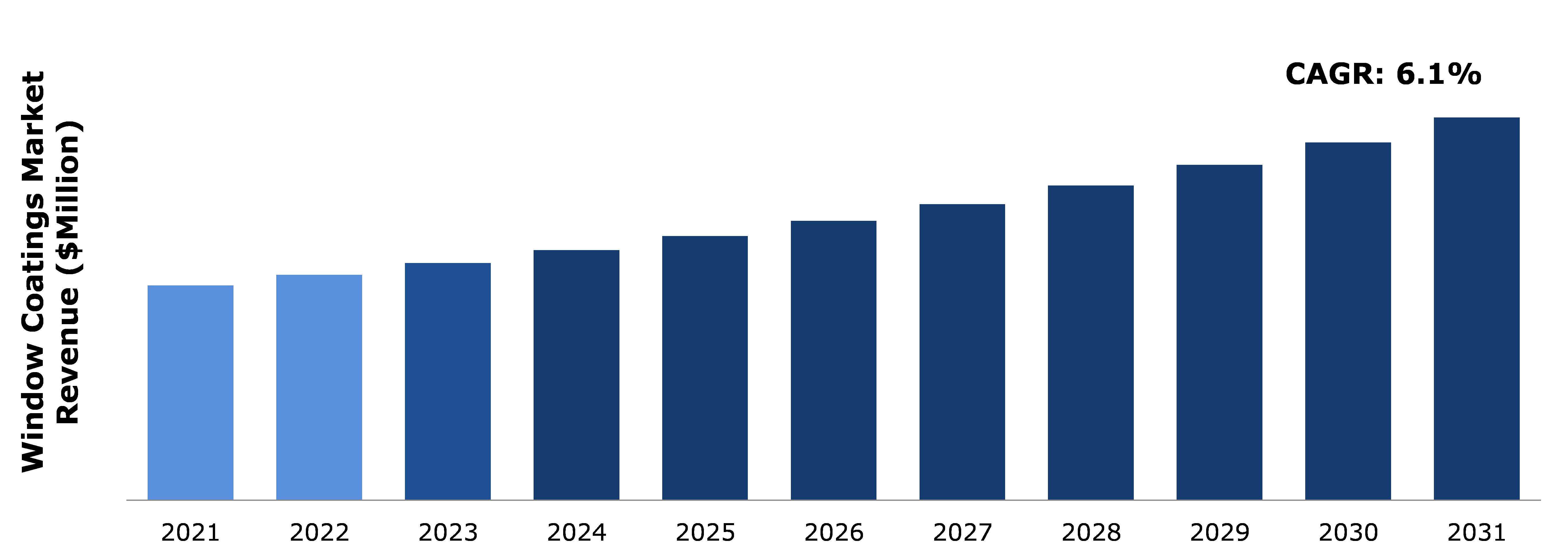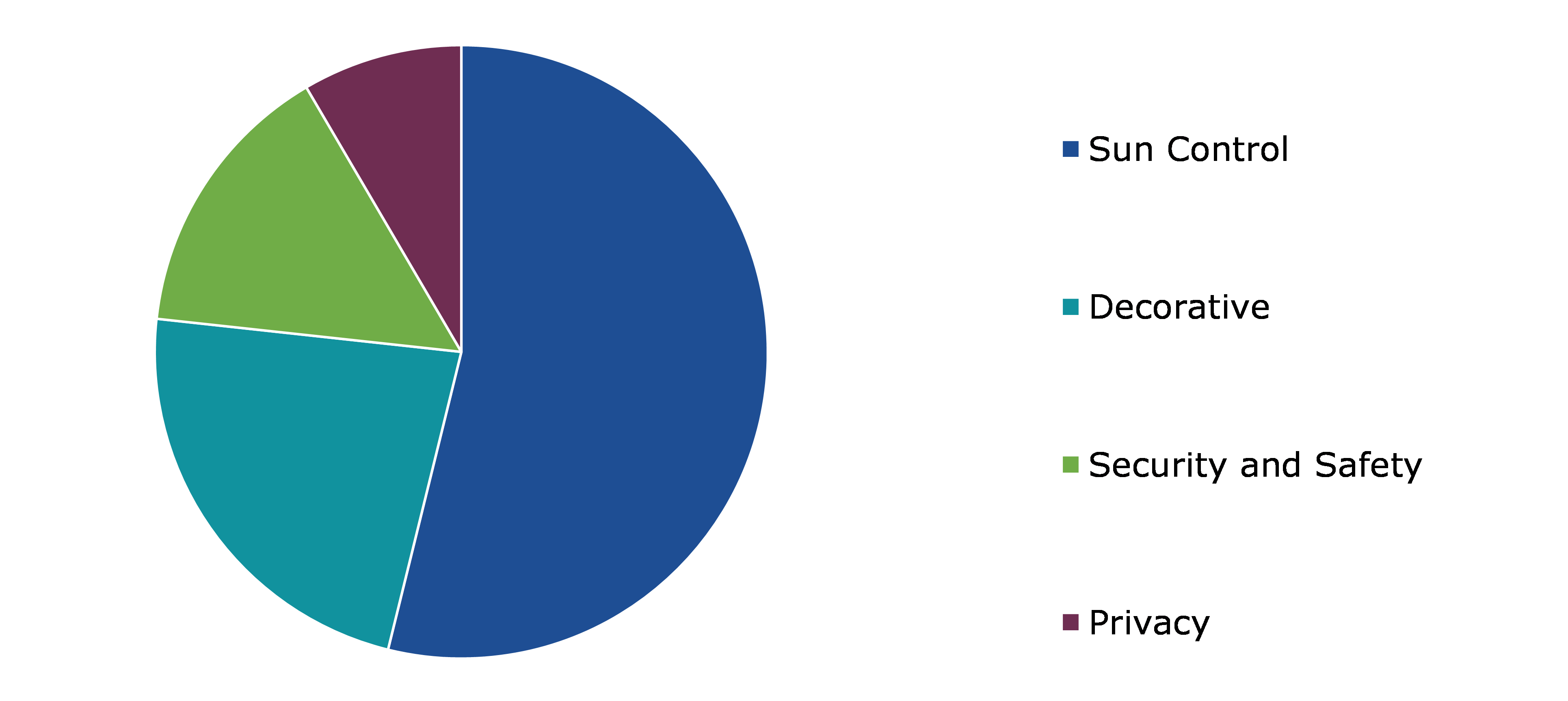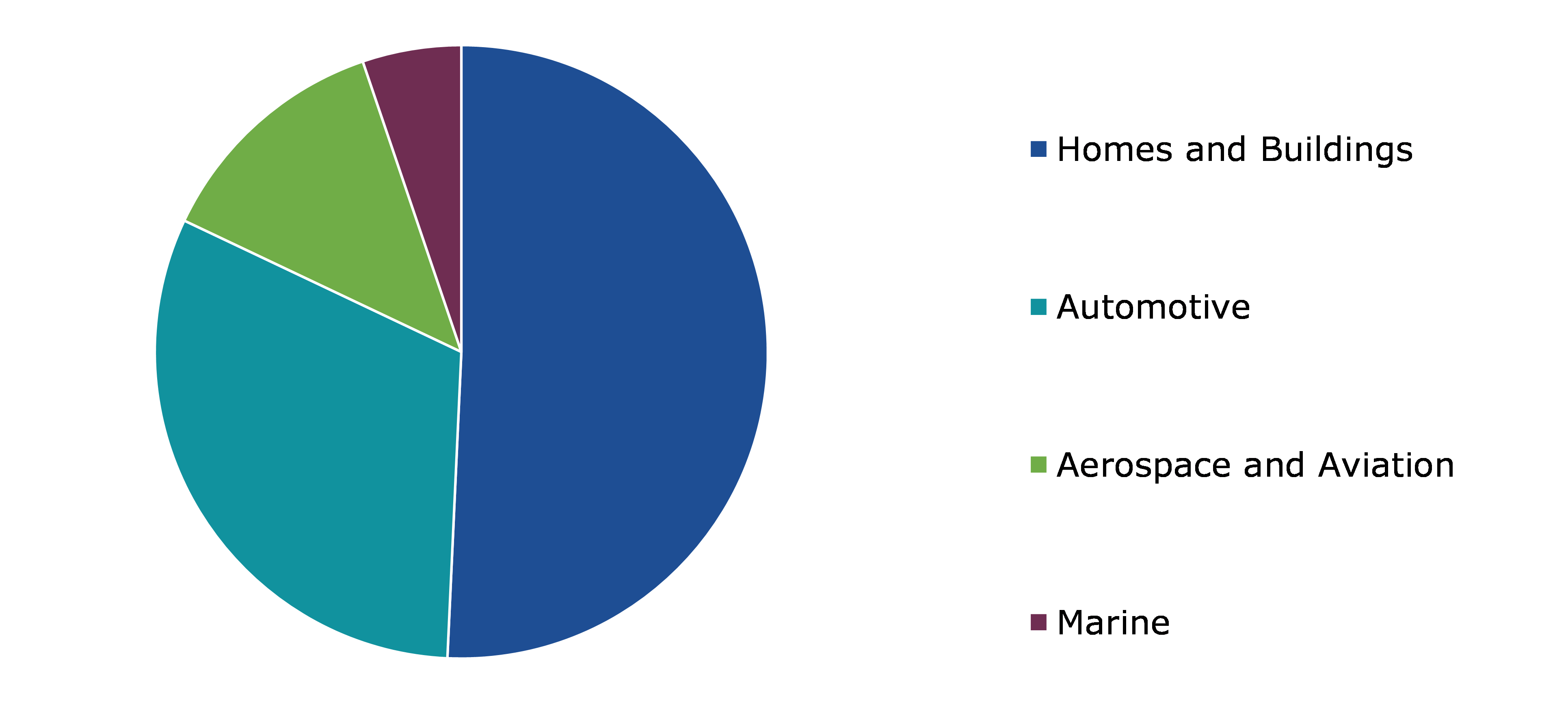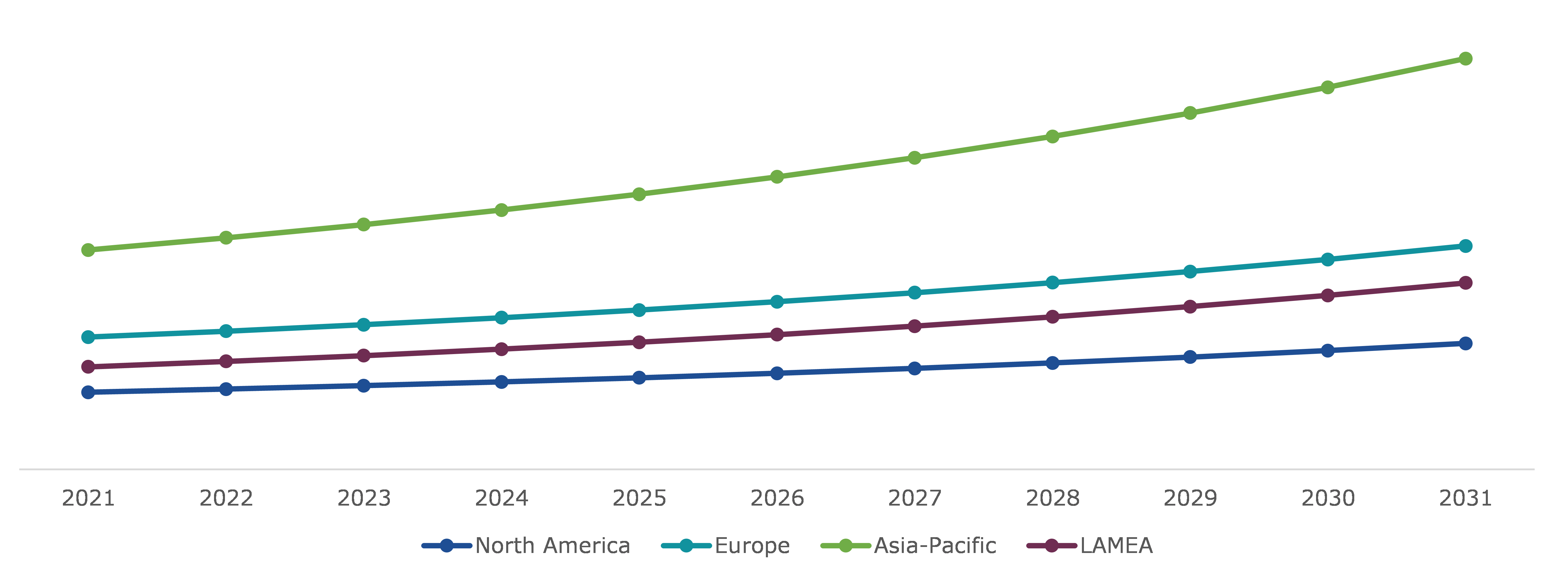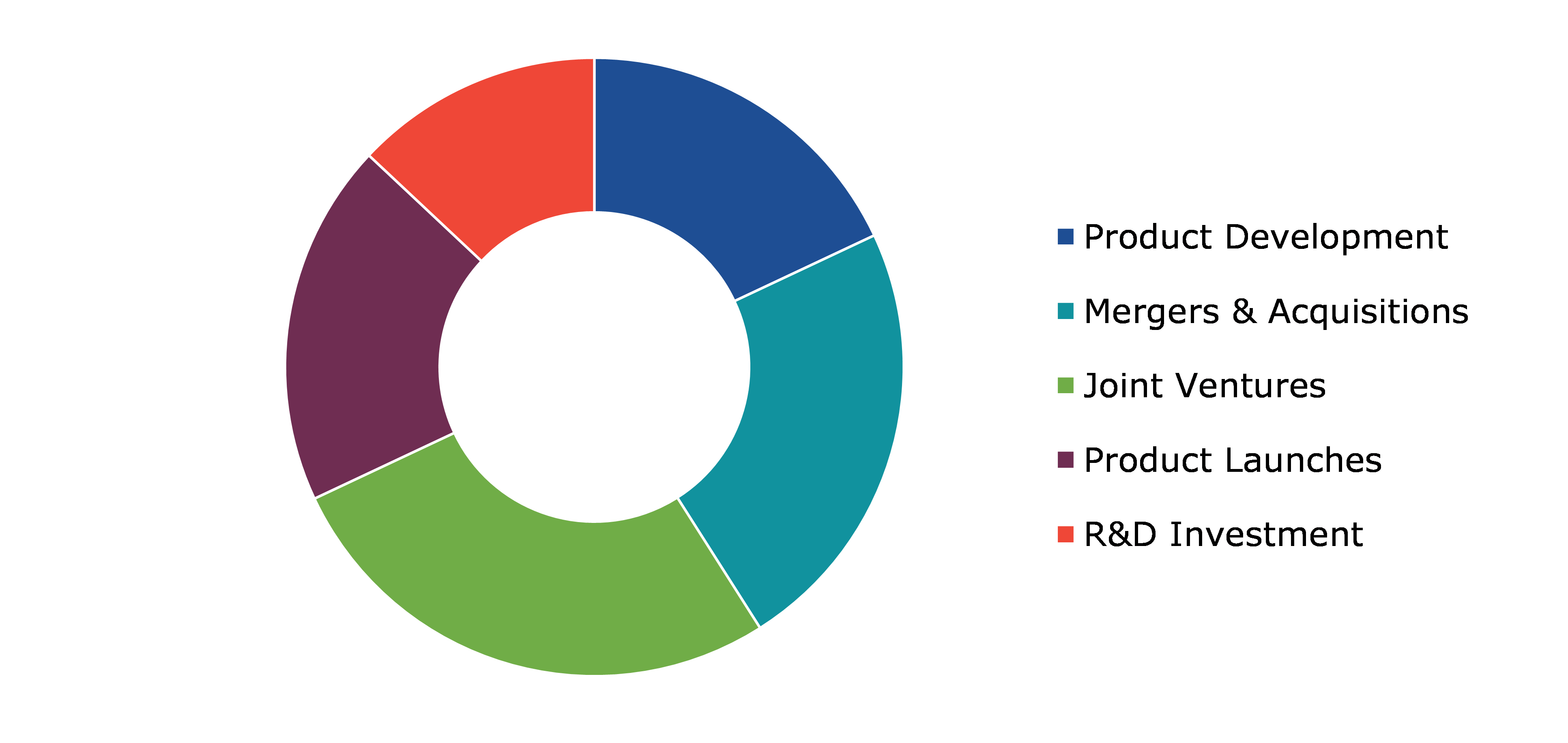Window Coatings Market Report
RA08567
Window Coatings Market by Product Use (Sun Control, Decorative, Security & Safety, and Privacy), End-use Industry (Homes & Buildings, Automotive, Aerospace & Aviation, and Marine), and Regional Analysis (North America, Europe, Asia-Pacific, and LAMEA): Global Opportunity Analysis and Industry Forecast, 2022–2031
Global Window Coatings Market Analysis
The Global Window Coatings Market Size was $10,794.4 million in 2021 and is predicted to grow with a CAGR of 6.1%, by generating a revenue of $19,236.9 million by 2031.
Global Window Coatings Market Synopsis
Window coatings market growth is majorly attributed to its ability to block a significant portion of the sun's UV rays, reducing the amount of UV radiation that enters a building through windows. This can help protect occupants in vehicles from the harmful effects of UV radiation, while also reducing the need for additional sun protection measures such as sunscreen or sunglasses. The rising concern about the harmful effects of UV radiation is expected to drive demand for window coatings that offer effective UV protection. This presents an opportunity for companies in the window coating market to develop innovative products that offer improved UV protection while also providing other benefits such as energy savings, improved durability, and enhanced aesthetics. These factors are anticipated to boost the window coatings market share in the upcoming years.
One of the market drawbacks for window coatings is the high initial cost of installation. Despite the potential for long-term energy savings and other benefits, the initial cost may be out of reach for some consumers or businesses. Another drawback is that if a window coating is damaged or no longer functional, it might be difficult or expensive to replace it. These factors are anticipated to hamper the window coatings market size during the forecast period. The demand for window coatings is rising owing to its various advantages, thereby driving the expansion of the global window coatings market. These advantages include glare reduction, energy savings, insulation, and others. In addition, its widespread use in residential and commercial buildings for sun control and blocking harmful UV rays to prevent furniture fading is anticipated to further propel the market development during the forecast period. These factors are projected to offer excellent opportunities to boost the window coatings market demand in the upcoming years.
According to regional analysis, the Asia-Pacific window coatings market is anticipated to show the fastest growth during the forecast period. Various government initiatives that aim at promoting energy efficiency along with rapid growth in commercial & residential construction is anticipated to boost the popularity of window coatings market in the upcoming years. Governments of various countries in Asia-Pacific have introduced initiatives aimed at promoting energy efficiency and reducing greenhouse gas emissions. This has created a favorable regulatory environment for the adoption of window coatings and other energy-efficient technologies.
Window Coatings Overview
Window coatings are thin layers applied to the glass' surface that have spectrally selective characteristics. They are distinguished by their capacity to control radiation energy levels within a range. These films can be used in a variety of industries, including shipbuilding, automotive, and residential and commercial construction. In addition, applying window coatings to the windows can enhance the appearance and look of the home décor.
COVID-19 Impact on Global Window Coatings Market
The COVID-19 pandemic had a significant impact on the window coatings industry. For instance, the demand for window coatings has been impacted by the slowdown in construction activities during the pandemic, including residential and commercial buildings. This is primarily due to the supply-chain issues and complete shutdown of all non-essential activities to stop the COVID-19 virus' spread. The shipments from abroad were stopped due to closed borders which has led to delays in the availability of raw materials. For instance, there was a severe shortage of premium polyester window coatings owing to the decreased chemical plant output which has delayed the manufacturing of window coatings. . Reduced consumer spending on non-essential goods and more tendency towards cash saving has affected the demand for high-end and luxury window coatings. With many consumers facing financial uncertainty, they were less likely to invest in expensive home improvement projects that include high-end window coatings. These factors have led to a negative impact on the window coatings market growth during the COVID-19 pandemic.
Growing Applications of Window Coatings in the Industrial Sector to Drive the Market Growth
Window coatings have gained significant popularity in renovation and re-modelling projects across the world. There is a growing trend towards smart and sustainable buildings, which has led to an increase in demand for energy-efficient window coatings. Window coatings help to maintain a comfortable indoor environment, reduce energy consumption, and improve the overall energy performance of buildings. Furthermore, the market for windows film is rising owing to the increase in industrialization and urbanization in developing countries. Hence, rising demand for window coatings is estimated to generate excellent opportunities for the manufacturers.
To know more about global window coatings market drivers, get in touch with our analysts here.
High Cost of Window Coatings to Restrain the Market Growth
Window coatings can be expensive, particularly if they are of high quality and designed for specific purposes such as energy efficiency or UV protection. The cost of the coating can be a barrier some consumers, particularly in regions where cost is a primary concern. The installation of window coatings can be challenging, particularly for larger windows or those with complex shapes. This may limit the adoption of window coatings in certain applications, particularly in retrofit or renovation projects where installation costs can be high. All these factors are projected to hamper the market revenue growth in the upcoming years.
The Growing Popularity of Smart Window Coatings to Drive Excellent Growth Opportunities
Window coatings are widely used architectural glazing applications owing to their static properties and dynamic optical properties. Smart window coatings can help to heat or cool home and leads to energy savings. Smart window coatings use advanced materials and technologies to change the properties of the glass in response to changes in the environment. For example, these coatings can switch from clear to opaque in response to changes in light or temperature, which can help to reduce energy consumption and improve the comfort of occupants. This factor is expected to create several growth opportunities for the key players operating in the market during the forecast period.
To know more about global window coatings market opportunities, get in touch with our analysts here.
Global Window Coatings Market, by Product Use
Based on product use, the market has been divided into sun control, decorative, security & safety, and privacy. Among these, the sun control sub-segment accounted for the highest market share in 2021 and is estimated to show the fastest growth during the forecast period.
Global Window Coatings Market Share, by Product Use, 2021
Source: Research Dive Analysis
The sun control sub-segment accounted for a dominant market share in 2021. The sun control segment is an important part of the window coatings market. Sun control coatings are designed to reduce the amount of solar heat that enters a building through windows, helping to keep the interior cooler and more comfortable while also reducing the need for air conditioning. The demand for sun control films is increasing owing to growing demand for energy-efficient products. Sun control coatings can help reduce energy consumption by reducing the amount of heat that enters a building, which can lead to lower cooling costs and a reduced carbon footprint. These aspects are anticipated to boost the popularity of sun control window coatings during the forecast period.
The decorative sub-segment is estimated to grow at a significant pace during the forecast period. Consumers are increasingly looking for window coatings that allow them to customize the appearance of their homes or buildings. This has led to a growing demand for decorative coatings can be customized in terms of color, pattern, and texture. Digital printing technology further made it easier and more cost-effective to produce customized window coatings customized designs and patterns. In addition, the use of smart technology, in window coatings can helps the consumers in customizing the window coatings based on color or pattern. The development of eco-friendly, sustainable coatings is further driving the growth of decorative coatings sub-segment.
Global Window Coatings Market, by End-use Industry
Based on end-use industry, the market has been divided into homes and buildings, automotive, aerospace and aviation, and marine. Among these, the homes and buildings sub-segment accounted for the highest revenue share in 2021 and this sub-segment is anticipated to show the fastest growth during the forecast period.
Global Window Coatings Market Trends, by End-use Industry, 2021
Source: Research Dive Analysis
The homes and buildings sub-segment accounted for a dominant market share in 2021 and is estimated to show the fastest growth during the forecast period. Homes and buildings account for a significant share of global energy consumption, and improving energy efficiency is a key priority for many governments, businesses, and individuals. Window coatings can help to reduce the amount of energy that is needed to heat or cool a building, making them an attractive option for improving the energy efficiency of homes and buildings. Also, window coatings can help to reduce the carbon footprint of buildings by reducing energy consumption and improving indoor air quality. These factors are anticipated to boost the popularity of window coatings across the homes and buildings sector during the forecast period.
Global Window Coatings Market, Regional Insights
The window coatings market was investigated across North America, Europe, Asia-Pacific, and LAMEA.
Global Window Coatings Market Size & Forecast, by Region, 2021-2031 (USD Million)
Source: Research Dive Analysis
The Market for Window Coatings in Asia-Pacific was the Most Dominant
The window coating market in Asia-Pacific accounted for the most dominant market share in 2021. Asia-Pacific is experiencing rapid urbanization, which is driving demand for new buildings and retrofitting of existing buildings. Therefore, there is an increase in demand for window coatings that can improve energy efficiency, reduce glare, and provide other benefits. The construction industry in Asia-Pacific is growing at a significant pace owing to rapid urbanization and development of smart cities. In addition, the Shanghai reports that by 2025, China will have equivalent of 10 New York cities built. Also, the China’s urban removal policy aims at developing greener and efficient cities. These factors are anticipated to propel the demand for window coatings in Asia-Pacific owing to high energy efficiency.
Competitive Scenario in the Global Window Coatings Market
Investment and agreement are common strategies followed by major market players. For instance, on June 19, 2018, SolarWindow Technologies, Inc announced its latest commercial alliance with nTact, a global leader in coatings process knowledge and equipment manufacturing, necessary for large-scale production of transparent electricity-generating windows.
Source: Research Dive Analysis
Some of the leading window coatings market players are 3M, Armolan, Avery Dennison Corporation, Eastman Chemical Company, Garware Suncontrol Film, LINTEC Corporation, Saint-Gobain, Polytronix, Inc., Purlfrost Ltd, and Solar Control Films Inc.
| Aspect | Particulars |
| Historical Market Estimations | 2020 |
| Base Year for Market Estimation | 2021 |
| Forecast Timeline for Market Projection | 2022-2031 |
| Geographical Scope | North America, Europe, Asia-Pacific, and LAMEA |
| Segmentation by Product Use |
|
| Segmentation by End-use Industry |
|
| Key Companies Profiled |
|
Q1. What is the size of the global window coatings market?
A. The size of the global window coatings market was over $10,794.4 million in 2021 and is projected to reach $19,236.9 million by 2031.
Q2. Which are the major companies in the window coatings market?
A. 3M, Armolan, Avery Dennison Corporation, and Eastman Chemical Company are some of the key players in the global window coatings market.
Q3. Which region, among others, possesses greater investment opportunities in the future?
A. Asia-Pacific possesses great investment opportunities for investors in the future.
Q4. What will be the growth rate of the Asia-Pacific window coatings market?
A. Asia-Pacific window coatings market is anticipated to grow at 6.6% CAGR during the forecast period.
Q5. What are the strategies opted by the leading players in this market?
A. Agreement and investment are the two key strategies opted by the operating companies in this market.
Q6. Which companies are investing more on R&D practices?
A. Garware Suncontrol Film, LINTEC Corporation, and Saint-Gobain are the companies investing more on R&D activities for developing new products and technologies.
1.Research Methodology
1.1.Desk Research
1.2.Real time insights and validation
1.3.Forecast model
1.4.Assumptions and forecast parameters
1.5.Market size estimation
1.5.1.Top-down approach
1.5.2.Bottom-up approach
2.Report Scope
2.1.Market definition
2.2.Key objectives of the study
2.3.Report overview
2.4.Market segmentation
2.5.Overview of the impact of COVID-19 on Global window coatings market
3.Executive Summary
4.Market Overview
4.1.Introduction
4.2.Growth impact forces
4.2.1.Drivers
4.2.2.Restraints
4.2.3.Opportunities
4.3.Market value chain analysis
4.3.1.List of raw material suppliers
4.3.2.List of manufacturers
4.3.3.List of distributors
4.4.Innovation & sustainability matrices
4.4.1.Technology matrix
4.4.2.Regulatory matrix
4.5.Porter’s five forces analysis
4.5.1.Bargaining power of suppliers
4.5.2.Bargaining power of consumers
4.5.3.Threat of substitutes
4.5.4.Threat of new entrants
4.5.5.Competitive rivalry intensity
4.6.PESTLE analysis
4.6.1.Political
4.6.2.Economical
4.6.3.Social
4.6.4.Technological
4.6.5.Environmental
4.7.Impact of COVID-19 on Window Coatings Market
4.7.1.Pre-covid market scenario
4.7.2.Post-covid market scenario
5.Window Coatings Market Analysis, by Product Use
5.1.Overview
5.2.Sun Control
5.2.1.Definition, key trends, growth factors, and opportunities
5.2.2.Market size analysis, by region
5.2.3.Market share analysis, by country
5.3.Decorative
5.3.1.Definition, key trends, growth factors, and opportunities
5.3.2.Market size analysis, by region
5.3.3.Market share analysis, by country
5.4.Security and Safety
5.4.1.Definition, key trends, growth factors, and opportunities
5.4.2.Market size analysis, by region
5.4.3.Market share analysis, by country
5.5.Privacy
5.5.1.Definition, key trends, growth factors, and opportunities
5.5.2.Market size analysis, by region
5.5.3.Market share analysis, by country
5.6.Research Dive Exclusive Insights
5.6.1.Market attractiveness
5.6.2.Competition heatmap
6.Window Coatings Market Analysis, by End-use Industry
6.1.Homes and Buildings
6.1.1.Definition, key trends, growth factors, and opportunities
6.1.2.Market size analysis, by region
6.1.3.Market share analysis, by country
6.2.Automotive
6.2.1.Definition, key trends, growth factors, and opportunities
6.2.2.Market size analysis, by region
6.2.3.Market share analysis, by country
6.3.Aerospace and Aviation
6.3.1.Definition, key trends, growth factors, and opportunities
6.3.2.Market size analysis, by region
6.3.3.Market share analysis, by country
6.4.Marine
6.4.1.Definition, key trends, growth factors, and opportunities
6.4.2.Market size analysis, by region
6.4.3.Market share analysis, by country
6.4.4.Coatings
6.5.Research Dive Exclusive Insights
6.5.1.Market attractiveness
6.5.2.Competition heatmap
7.Window Coatings Market, by Region
7.1.North America
7.1.1.U.S.
7.1.1.1.Market size analysis, by Product Use
7.1.1.2.Market size analysis, by End-use Industry
7.1.2.Canada
7.1.2.1.Market size analysis, by Product Use
7.1.2.2.Market size analysis, by End-use Industry
7.1.3.Mexico
7.1.3.1.Market size analysis, by Product Use
7.1.3.2.Market size analysis, by End-use Industry
7.1.4.Research Dive Exclusive Insights
7.1.4.1.Market attractiveness
7.1.4.2.Competition heatmap
7.2.Europe
7.2.1.Germany
7.2.1.1.Market size analysis, by Product Use
7.2.1.2.Market size analysis, by End-use Industry
7.2.2.UK
7.2.2.1.Market size analysis, by Product Use
7.2.2.2.Market size analysis, by End-use Industry
7.2.3.France
7.2.3.1.Market size analysis, by Product Use
7.2.3.2.Market size analysis, by End-use Industry
7.2.4.Spain
7.2.4.1.Market size analysis, by Product Use
7.2.4.2.Market size analysis, by End-use Industry
7.2.5.Italy
7.2.5.1.Market size analysis, by Product Use
7.2.5.2.Market size analysis, by End-use Industry
7.2.6.Rest of Europe
7.2.6.1.Market size analysis, by Product Use
7.2.6.2.Market size analysis, by End-use Industry
7.2.7.Research Dive Exclusive Insights
7.2.7.1.Market attractiveness
7.2.7.2.Competition heatmap
7.3.Asia-Pacific
7.3.1.China
7.3.1.1.Market size analysis, by Product Use
7.3.1.2.Market size analysis, by End-use Industry
7.3.2.Japan
7.3.2.1.Market size analysis, by Product Use
7.3.2.2.Market size analysis, by End-use Industry
7.3.3.India
7.3.3.1.Market size analysis, by Product Use
7.3.3.2.Market size analysis, by End-use Industry
7.3.4.Australia
7.3.4.1.Market size analysis, by Product Use
7.3.4.2.Market size analysis, by End-use Industry
7.3.5.South Korea
7.3.5.1.Market size analysis, by Product Use
7.3.5.2.Market size analysis, by End-use Industry
7.3.6.Rest of Asia-Pacific
7.3.6.1.Market size analysis, by Product Use
7.3.6.2.Market size analysis, by End-use Industry
7.3.7.Research Dive Exclusive Insights
7.3.7.1.Market attractiveness
7.3.7.2.Competition heatmap
7.4.LAMEA
7.4.1.Brazil
7.4.1.1.Market size analysis, by Product Use
7.4.1.2.Market size analysis, by End-use Industry
7.4.2.Saudi Arabia
7.4.2.1.Market size analysis, by Product Use
7.4.2.2.Market size analysis, by End-use Industry
7.4.3.UAE
7.4.3.1.Market size analysis, by Product Use
7.4.3.2.Market size analysis, by End-use Industry
7.4.4.South Africa
7.4.4.1.Market size analysis, by Product Use
7.4.4.2.Market size analysis, by End-use Industry
7.4.5.Rest of LAMEA
7.4.5.1.Market size analysis, by Product Use
7.4.5.2.Market size analysis, by End-use Industry
7.4.6.Research Dive Exclusive Insights
7.4.6.1.Market attractiveness
7.4.6.2.Competition heatmap
8.Competitive Landscape
8.1.Top winning strategies, 2021
8.1.1.By strategy
8.1.2.By year
8.2.Strategic overview
8.3.Market share analysis, 2021
9.Company Profiles
9.1.3M
9.1.1.Overview
9.1.2.Business segments
9.1.3.Product portfolio
9.1.4.Financial performance
9.1.5.Recent developments
9.1.6.SWOT analysis
9.2.Armolan
9.2.1.Overview
9.2.2.Business segments
9.2.3.Product portfolio
9.2.4.Financial performance
9.2.5.Recent developments
9.2.6.SWOT analysis
9.3.Avery Dennison Corporation
9.3.1.Overview
9.3.2.Business segments
9.3.3.Product portfolio
9.3.4.Financial performance
9.3.5.Recent developments
9.3.6.SWOT analysis
9.4.Eastman Chemical Company
9.4.1.Overview
9.4.2.Business segments
9.4.3.Product portfolio
9.4.4.Financial performance
9.4.5.Recent developments
9.4.6.SWOT analysis
9.5.Garware Suncontrol Film
9.5.1.Overview
9.5.2.Business segments
9.5.3.Product portfolio
9.5.4.Financial performance
9.5.5.Recent developments
9.5.6.SWOT analysis
9.6.LINTEC Corporation
9.6.1.Overview
9.6.2.Business segments
9.6.3.Product portfolio
9.6.4.Financial performance
9.6.5.Recent developments
9.6.6.SWOT analysis
9.7.Saint-Gobain
9.7.1.Overview
9.7.2.Business segments
9.7.3.Product portfolio
9.7.4.Financial performance
9.7.5.Recent developments
9.7.6.SWOT analysis
9.8.Polytronix, Inc.
9.8.1.Overview
9.8.2.Business segments
9.8.3.Product portfolio
9.8.4.Financial performance
9.8.5.Recent developments
9.8.6.SWOT analysis
9.9.Purlfrost Ltd.
9.9.1.Overview
9.9.2.Business segments
9.9.3.Product portfolio
9.9.4.Financial performance
9.9.5.Recent developments
9.9.6.SWOT analysis
9.10.Solar Control Films Inc.
9.10.1.Overview
9.10.2.Business segments
9.10.3.Product portfolio
9.10.4.Financial performance
9.10.5.Recent developments
9.10.6.SWOT analysis
Concerns regarding the adverse impacts of UV radiation on people's health have grown in recent years. UV light exposure can result in skin damage, early ageing, and a higher risk of skin cancer. As a result, it is critical to avoid prolonged sun exposure. One method for reducing the adverse impacts of UV light on human health is to use specialty window glass. This is where the window coating solution comes in.
The window coatings market is the industry that manufactures and distributes coatings for use on windows and other glass surfaces. Window coatings are thin layers of glass that have spectrally selective properties. They can regulate radiation energy levels within a range, which makes them stand out. These coatings or films can be employed in a wide range of fields, such as shipbuilding, automobiles, commercial, and residential construction. Furthermore, installing window coatings can improve the home's interior design, hence their demand is rising in residential constructions.
Recent Trends in the Window Coatings Market
The window coatings market is continuously evolving with new technologies and materials. Smart windows are a relatively recent technology that enables users to manage the amount of heat and light that enters a building via the windows. Depending on the user's preferences, these windows can be tinted or opaque, and they can also be managed remotely via a smartphone app or another device. Moreover, low-emissivity (low-e) window coatings are intended to increase energy efficiency and save on heating and cooling expenses by limiting heat transmission through windows. These coatings can be used on both residential and commercial windows and are manufactured from thin layers of metallic elements.
Newest Insights in the Window Coatings Market
As per a report by Research Dive, the global window coatings market is expected to grow at a CAGR of 6.1% and generate revenue of $19,236.9 million by 2031. The primary factors driving the growth of the market are the growing concern about the negative effects and the increase in demand for window coatings due to their many benefits over UV radiation, including glare reduction, insulation, energy savings, and other benefits. However, the high initial cost of window coating installation is expected to hinder the market growth.
The window coatings market in Asia-Pacific is expected to remain dominant in the coming years. The region's high revenue in 2021 was driven by increasing urbanization and a rise in demand for window coatings that can minimize glare and promote energy efficiency. This has led to an increased demand for innovative and efficient window coating solutions that can meet individual needs and challenges.
How are Market Players Responding to the Rising Demand for Window Coatings?
Market players are responding to the rising demand for window coatings by investing in research and development to create more advanced and innovative window coatings. They are additionally researching novel materials and technologies that could enhance the performance of window coatings, such as their energy efficiency, clarity, and durability.
In addition, market players are increasingly focusing on strategic partnerships and collaborations with other players in the industry to leverage their strengths and expand their reach. Some of the foremost players in the window coatings market are Armolan, 3M, Avery Dennison Corporation, Garware Suncontrol Film, Eastman Chemical Company, LINTEC Corporation, Purlfrost Ltd., Polytronix, Inc., Solar Control Films, Inc., Saint-Gobain, and others. These players are focused on implementing strategies such as mergers and acquisitions, novel developments, collaborations, and partnerships to reach a leading position in the global market.
For instance:
- In December 2020, STEK Automotive, a U.S.-based developer of film technology, launched NEX, a high-end nano-ceramic window film of graphene, tungsten, and antimony tin oxide.
- In April 2022, Avery Dennison, a global producer and supplier of materials for pressure-sensitive adhesives, announced the launch of its brand-new Dusted Crystal decorative architectural window film. The frosted film, which comes in matte and lustre finishes, provides privacy and creates a translucent light impression for interior environments that use glass to signify specifically designated places.
- In February 2023, High-Performance Optics, a world leader in driving the need for HEVL protection for the human eye, in collaboration with Eastman, a multinational specialized materials company that manufactures a wide range of products, announced the launch of a new window film in China that is specifically made for the transportation sector and has selective High Energy Visible Light (HEVL) filtering.
COVID-19 Impact on the Global Window Coatings Market
The COVID-19 pandemic had an adverse impact on the global window coatings market. During the pandemic, construction activities slowed down, including residential and commercial structures, which had an effect on the window coatings market. This is mainly because of difficulties with the supply chain and a complete halt of all not essential activities in order to curb the COVID-19 virus's spread. Moreover, shipments from abroad were halted owing to restricted borders, causing delays in the supply of raw materials. The market for high-end and luxury window coatings was impacted by decreased consumer expenditure on unnecessary products and a higher trend towards cash savings. These factors significantly hindered the market growth amidst the pandemic.
Personalize this research
- Triangulate with your own data
- Request your format and definition
- Get a deeper dive on a specific application, geography, customer or competitor
- + 1-888-961-4454 Toll - Free
- support@researchdive.com

